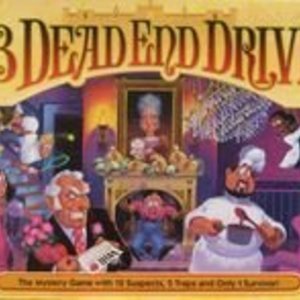
Citymapper Transit Navigation
Navigation and Travel
App
Real-time departures. Transit maps. Line status and real-time disruption alerts. Uber integration....
Matthew Krueger (10051 KP) rated 13 Dead End Drive in Tabletop Games
Jul 17, 2020 (Updated Jul 18, 2020)
13 Dead End Drive is a murder-themed board game originally from Milton Bradley. Released in 1993, it was followed in 2002 by a sequel, 1313 Dead End Drive. Currently, Winning Moves Games USA Winning Moves publishes the game in the USA.
The story behind the game involves the death of a wealthy old woman triggering a feud over her will. The players utilize traps located on the game board, which represents a mansion, to kill characters controlled by other players in order to claim the estate for themselves.
The Gameplay:
At the start of gameplay, players are dealt "Character cards" which correspond to matching pawns on the board. Since there are 12 characters, it is often the case that players control more than one character. However, which player controls which character is not revealed. Along with the character cards, there are also Portrait Cards, which determine who the current favorite for the inheritance is, and Trap Cards, which are used to spring traps and knock off other players.
During each turn, a player rolls two dice and moves two pawns, one pawn for each die. It is legal for players to move a pawn that is not theirs in order to bring it closer to or onto a Trap Space. All pawns must be moved off the red chair spaces before any pawns can be moved a second time or onto a trap space. If a pawn is moved onto a trap space by exact roll only, the player must have the corresponding trap card in his or her possession in order to spring the trap. Springing traps is not mandatory, however. After that, play proceeds on to the next player. A pawn can not pass through or land on the same space as another pawn during the same turn.
During the game, a Portrait Card is displayed in the picture frame above the fireplace. That character is now the current favorite to inherit the fortune. At that moment, for all intents and purposes, that character is now marked for death and must try to escape the mansion before he or she is either knocked off or the portrait changes (see "Special Spaces and Rules" below).
Also, during the game, a Detective is waiting outside, slowly advancing toward the front door. His arrival signifies the reading of the will and the announcement of the winner. The Detective can only move one space at a time, and only when a Detective Card (hidden inside the Trap Card pile) is drawn. There are 13 steps to the front door. If the Detective makes it to the front door before all other characters have been eliminated, the game is over.
Ways to win:
There are three ways to win 13 Dead End Drive:
Be the last character alive.
Escape the Mansion while your character's picture is displayed in the Picture Frame.
Have your character's picture displayed in the Picture Frame when the Detective reaches the front door.
Traps:
13 Dead End Drive has five different booby traps that are used to dispose of other characters. In the story of the game, the traps are designed to make deaths appear accidental. The traps are the Chandelier, the Bookcase, the Stairs, a Statue in a suit of armor, and the Fireplace: if a pawn has the misfortune to land on the trap space in front of or under one of these traps, the Trap card is played and the trap is sprung in the following ways:
To activate the Chandelier, flip a switch in the music room that drops the chandelier onto the pawn, eliminating it from play.
To activate the Bookcase, move that pawn up onto the top of the ladder and rest that pawn on top of the bookcase in the library, and flip a switch that will send the pawn flying back onto the board and eliminating it from play.
In order to activate the Stairs, a player can move it up onto the top of the stairs in the hall and flip a switch that will violently toss the pawn back down the stairs and onto the board, resulting in its elimination.
To activate the Statue, in the gallery, a player can flip a switch that will send a statue in a full suit of armor crashing down onto the pawn.
The Fireplace is activated in the dining room when a player flips a switch that will send the pawn flying backwards and into the figurative fire, though the box describes it as a Trap Door.
When a player moves a pawn onto a Trap Space, they must draw a card from the Trap Card pile (if they do not already have the matching trap card in their possession). If the player draws the matching Trap Card, they can either play it immediately or hold the card for future use. If the player does not have the matching Trap Card, the trap cannot be sprung, but the card can be saved for future use. There are also "Wild" Trap Cards which permit all traps to be used anytime a pawn is in that space. If, however, the player draws a Detective card, the Detective is moved one space forward, but the player is permitted to draw another Trap Card before ending the turn.
Once a trap is sprung, that pawn and the matching Character Card are laid down on the "Discard" pile on the board (the couch). If during the course of play, a Portrait Card comes up for a character that has been knocked off, that card is immediately taken down and placed on the "Discard" pile, revealing a new Portrait. The Portrait cards are shuffled at the beginning of gameplay and concealed by an "Aunt Agatha" portrait card to hide the known deck order.
Special spaces and rules:
Rolling Doubles: If a player rolls doubles that player chooses whether or not to move the current Portrait card to the back of the pack to reveal new Portrait. The player then has the choice of:
Moving one pawn the total number of spaces shown on the dice, or
Moving two pawns, one pawn for each die.
Secret Passages: On the board are special spaces that represent "Secret Passages."
Any character can enter any secret passage at any time, regardless of whether or not it is by exact roll. Moving from one secret passage to another counts as one space move for a character. Secret passages are often used to bring opponent's pawns closer to traps or to bring a player's own pawn closer to the door.
Bluffing: Bluffing is permitted in "13 Dead End Drive." In terms of strategy, a player may move their own pieces towards or even onto trap spaces in an attempt to fool opponents. Even if that player has the matching trap card for the space their own character is on, they do not have to play it. Instead, they can pretend that they do not have the correct card and draw another one. If they happen to draw the right trap card, they can pretend that the card is the wrong one, and play continues as normal.
Its a excellent game, if you like clue than you will love this game. Its a excellent bluff deduction murder mystery game.
Hazel (1853 KP) rated Station Eleven in Books
May 30, 2017
The dystopian idea of a virus wiping out most of the world’s human inhabitants is not a new concept. It has be done and retold over and over again. Emily St. John Mandel’s invention of the Georgian Flu is no different from these. Brought to Canada and the USA by a passenger on a plane from Russia, the highly contagious virus spreads quickly from person to person, town to town, and once caught you are dead within forty-eight hours.
The difference between Station Eleven and other novels of apocalyptic themes is that the story takes place primarily in two time periods – pre-Georgian Flu and twenty years post-Georgian flu – rather than during the outbreak and the immediate days after (although there are a few scenes written within that timeframe). It is difficult to explain the storyline without giving too much away. Although the death of millions of people is a vital feature, it is the lives of the characters that are important. All the significant characters are in some way linked to one man, Arthur Leander, and, particularly in the case of one individual, a graphic novel titled Station Eleven.
The book opens in Toronto with Arthur, a Hollywood actor, starring in a stage production of King Lear. Despite the quick reaction of trainee paramedic Jeevan, Arthur dies of a heart attack after suddenly collapsing during the forth act. Then suddenly, that same night, the Georgian flu makes its first appearance in Canada. Despite this occurring right at the beginning, it is not the last the reader sees of Arthur. Throughout the story the author returns to Arthur, recounting scenes of his life from acting career to his three ex-wives and only child.
Twenty years after the Georgian flu, Kirsten Raymonde, who starred as a child in the same production of King Lear, is part of the Traveling Symphony: a group of actors and musicians walking from decaying-town-to-town performing a number of Shakespeare plays as they go. With her she carries two Station Eleven comics that Arthur gave her before he died – incidentally written and drawn by his first wife. Most people that the Symphony encounter are accommodating and are trying their best to live in a world of no electricity or health care, but then they meet a man who calls himself the Prophet. Believing that he has been given a duty by God to repopulate the world he preaches to the people telling them that everything happens for a reason, likening the epidemic to Noah’s flood in the Bible. However it soon becomes clear that he is a dangerous character.
In a way it is heartening to imagine that high culture (such as Shakespeare and orchestral music) survives in a world that has been destroyed. Shakespeare was born in a time before all the modern inventions relied upon today, and now, in this novel, it is once again an electricity-less era yet these historical things live on.
One problem with Station Eleven is that it is hard to pinpoint the exact plot line. There is the life story of Arthur Leander, his wives and a close friend. Then there is Kirsten living a completely different life. Nonetheless it is still an incredibly fascinating book. Although it flits between time periods it is thankfully not as confusing as some may imagine it would be.
Even though dystopian novels of this nature have been done before, Station Eleven is definitely a book to read; and through it all it poses the question of how you, the reader, would survive in such a world.
Hazel (1853 KP) rated Station Eleven in Books
Dec 7, 2018
The dystopian idea of a virus wiping out most of the world’s human inhabitants is not a new concept. It has be done and retold over and over again. Emily St. John Mandel’s invention of the Georgian Flu is no different from these. Brought to Canada and the USA by a passenger on a plane from Russia, the highly contagious virus spreads quickly from person to person, town to town, and once caught you are dead within forty-eight hours.
The difference between <i>Station Eleven</i> and other novels of apocalyptic themes is that the story takes place primarily in two time periods – pre-Georgian Flu and twenty years post-Georgian flu – rather than during the outbreak and the immediate days after (although there are a few scenes written within that timeframe). It is difficult to explain the storyline without giving too much away. Although the death of millions of people is a vital feature, it is the lives of the characters that are important. All the significant characters are in some way linked to one man, Arthur Leander, and, particularly in the case of one individual, a graphic novel titled <i>Station Eleven</i>.
The book opens in Toronto with Arthur, a Hollywood actor, starring in a stage production of <i>King Lear</i>. Despite the quick reaction of trainee paramedic Jeevan, Arthur dies of a heart attack after suddenly collapsing during the forth act. Then suddenly, that same night, the Georgian flu makes its first appearance in Canada. Despite this occurring right at the beginning, it is not the last the reader sees of Arthur. Throughout the story the author returns to Arthur, recounting scenes of his life from acting career to his three ex-wives and only child.
Twenty years after the Georgian flu, Kirsten Raymonde, who starred as a child in the same production of <i>King Lear</i>, is part of the Traveling Symphony: a group of actors and musicians walking from decaying-town-to-town performing a number of Shakespeare plays as they go. With her she carries two <i>Station Eleven</i> comics that Arthur gave her before he died – incidentally written and drawn by his first wife. Most people that the Symphony encounter are accommodating and are trying their best to live in a world of no electricity or health care, but then they meet a man who calls himself the Prophet. Believing that he has been given a duty by God to repopulate the world he preaches to the people telling them that everything happens for a reason, likening the epidemic to Noah’s flood in the Bible. However it soon becomes clear that he is a dangerous character.
In a way it is heartening to imagine that high culture (such as Shakespeare and orchestral music) survives in a world that has been destroyed. Shakespeare was born in a time before all the modern inventions relied upon today, and now, in this novel, it is once again an electricity-less era yet these historical things live on.
One problem with <i>Station Eleven</i> is that it is hard to pinpoint the exact plot line. There is the life story of Arthur Leander, his wives and a close friend. Then there is Kirsten living a completely different life. Nonetheless it is still an incredibly fascinating book. Although it flits between time periods it is thankfully not as confusing as some may imagine it would be.
Even though dystopian novels of this nature have been done before, <i>Station Eleven</i> is definitely a book to read; and through it all it poses the question of how you, the reader, would survive in such a world.

NBA JAM by EA SPORTS™
Games and Entertainment
App
Read on for important info below! BOOMSHAKALAKA!!! Jam with a friend in Local Multiplayer and rock...

FarFaria Stories To Read Along
Education and Book
App
- “Brain Expander” –Parenting Magazine - “Netflix for Children's Books!” –USA Today -...

CompareMe Shopping Calculator
Shopping and Finance
App
CompareMe helps you to save money by comparison shopping. Compare products in different sizes in...

ColRegs: Rules of the Road for all Seagoing Sail and Power Vessels
Education and Navigation
App
Quick learning & revision tool, over 100 graphics, for all seafarers worldwide. "... a brilliant...

Tynker Coding for Kids
Education
App
Tynker is the easiest way for kids to learn programming. Solve fun puzzles using visual blocks or...

Mosaic Photo Books by Mixbook
Shopping and Catalogs
App
Featured on The Today Show as ‘One of our favorite gifts’ and Good Morning America's ‘Deals...

